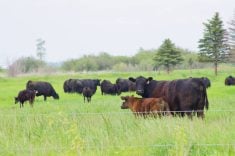A few squinty, tearful cattle during the summer are likely the start of a pinkeye outbreak.
Also going by the name infectious bovine keratoconjunctivitis, it is the most common eye disease in cattle.
Affected cattle exhibit the red or pink discoloration of the eye, excessive tear production, squinting, whitening of the cornea and sometimes deeper wounds to the cornea.
In rare cases, severely affected eyes can completely rupture, resulting in blindness.
Scars form on the surface of the eye as the ulcers heal, leaving a permanent record of past infection.
Read Also

House ag committee to undertake several studies
The House of Commons standing agriculture committee has set its agenda for the coming months. Members began the fall sitting with a two-hour update on international trade
Cases of infectious bovine rhinotracheitis (IBR) can also cause eyes to look red, so it is important to distinguish between the two. Pinkeye does not lead to pneumonia or respiratory signs.
Controversy exists over what causes pinkeye, but it is generally thought to be associated with the bacteria moraxella bovis. Experimental infections with a different, closely related bacteria, moraxella bovoculi, failed to cause pinkeye.
Moraxella bovis have little finger-like projections that permit adhesion to the surface of the eye. Once attached, the bacteria produces toxins that damage the cornea.
Various environmental and management factors can increase the risk of pinkeye, including flies, sunlight, stress and dusty or windy conditions.
As with many diseases, asymptomatic carriers can maintain the bacteria in their nasal cavities and serve as a source of infection for future outbreaks.
Cattle of any age can become in-fected, but calves are particularly susceptible.
An outbreak of pinkeye can be managed through isolating affected individuals, fly control, provision of shaded areas and/or antibiotic treatment, depending on the particular circumstances and the advice of the treating veterinarian.
Most cattle make a complete recovery so the effects of pinkeye tend to be related to production and growth. Reduced appetite or ability to locate feeders results in weight loss and failure to gain.
Genetic susceptibility to pinkeye is in the early stages of discovery.
For example, Herefords are known to have increased risk of pinkeye, but the mechanism for this susceptibility remains elusive.
A few genes have been linked to increased susceptibility, but preliminary results indicate that heritability is low for disease resistance.
Breeding specific individuals for their resistance to pinkeye remains a future possibility once the genetics of this disease are more clearly understood.
Copper deficiency has been linked to increased susceptibility to the disease. It is an important mineral for the immune system, which means too little copper can have widespread effects on disease resistance through its impact on the immune system.
Bench-top laboratory research has shown that the bacteria that causes pinkeye is capable of forming biofilms.
Familiar, everyday biofilms include the slimy ring near the taps in a bathroom or plaque on teeth. They are a microscopic community of bacteria that produce their own adhesive meshwork, making them resistant to cleaning, the immune system and antibiotics.
Further research is necessary to establish the presence of morexalla bovis biofilms in clinical cases, but if this bacteria were a biofilm producer, it would help explain the rapid clinic progression and resistance to treatment. It might also lead to novel treatment methods.
The economic impacts from the reduced weight gain are substantial, with one estimate in the United States pegged at $150 million a year. These production losses occur not only from decreased weaning weights but also from the time and expense of treatment.
Recent research found that production losses associated with pinkeye persisted far beyond the weaning period into the yearling stage. Calves with pinkeye are not able to catch up compared to their unaffected herd mates.
Effective vaccination remains the holy grail of pinkeye prevention. A small study using intranasal vaccination found increased antibodies in tears of vaccinated cattle, and it may be the way of the future.
However, much work remains to be done to prove its effectiveness.

















